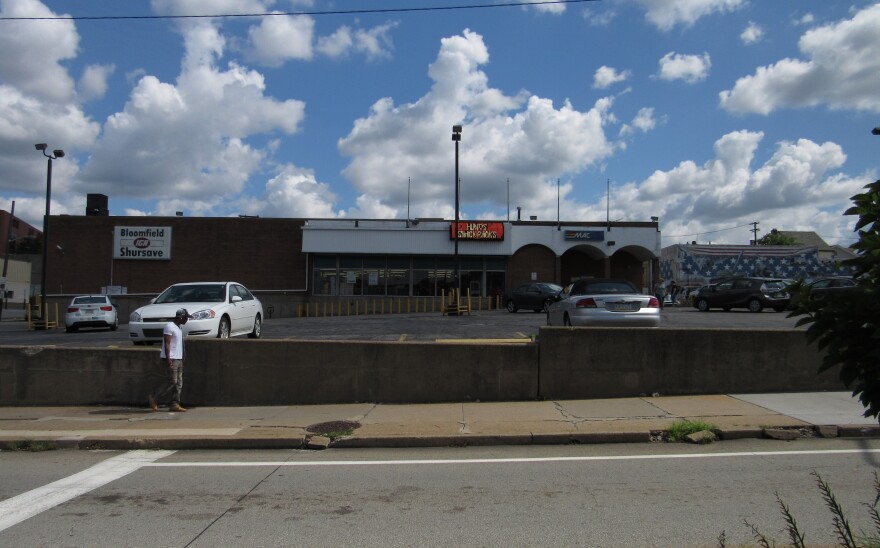Christina Howell waves and smiles at neighbors as she walks toward Bloomfield’s main drag on a sweltering July morning. She’s lived nearby for 12 years, and she loves the place.
“I remember walking down Liberty Avenue when I was looking at my house,” she says. “It just really felt like a very cozy neighborhood. It feels like a very warm, welcoming place. And it’s super walkable.”
But Howell worries recent development could shift that rooted, welcoming atmosphere.

Milhaus Development unveiled a proposal for a high-end apartment complex on the site of the Bloomfield Shursave IGA at a community meeting organized by Howell in January. The two-acre lot at the north end of the Bloomfield Bridge has been home to a grocery store for over 35 years, but for the last three of those, it’s been on the market, as its operator prepares to retire.
Howell, executive director of the Bloomfield Development Corporation, stood in the wings as residents cheered taking Milhaus’ vice president of development Thomas Bost to task. Rents in Bloomfield are already on the rise, they said. How would another luxury apartment building – built in place of the neighborhood’s only full-service grocery store – affect that?
“So the rents here at 4401 Liberty Avenue – we’re planning to start at $1,000 and go up to $2,500. But we understand that [rising rent prices] is an issue that’s not just with Bloomfield, but Pittsburgh in general,” Bost told the group.

At the beginning of this year, multi-family apartment buildings, which opened in 2017, had a 40 percent vacancy rate, according to a report by market analysis firm CoStar. Shana Callahan, CoStar’s Pittsburgh analyst, said that’s now down to about 30 percent, but that doesn’t account for the estimated 2,500 new units still under construction.
Milhaus declined to comment for this story, and that night, Bost didn’t address how or who Milhaus expects to fill those 237 units.
Developers, including Milhaus, have maintained these new complexes—with private pools, outdoor grills and recreation areas—cater to millennial expectations. Callahan doesn’t disagree, and said Pittsburgh actually has a problem retaining 18-40 year olds.
“I have seen over the last year that age cohort has increased a little bit,” she said, “but not the kind of growth that you ideally would want to see.”
Pittsburgh boasts universities, high-tech start-ups, a relatively low-cost of living and a growing restaurant and bar scene, but Callahan said something isn’t clicking. Pittsburgh isn’t alone; Rust Belt cities across the country are trying to capitalize on the same wave of reinvention, she said, often through roughly defined downtown areas. But for some reason—one Callahan can’t put her finger on—Pittsburgh isn’t retaining its young population as well as Cincinnati, for example.
And even if adults under 40 are the target, that means all these new developments are scrabbling for the same population to fill their units.
“If investors and landlords are seeing that there are people driven to this new property, they’re definitely going to judge how quickly that new building leases up, and I’m sure they will raise rents,” Callahan said.

Miles Dinnen lived and worked around Bloomfield for about a decade in the early 2000s. Dinnen said rent at different apartments in the neighborhood never exceeded $500, and sometimes that included utilities. But when Dinnen and a former partner began looking for a house in Bloomfield, they couldn’t find anything in their budget. Dinnen eventually settled on a home in Millvale.
Sarah Abbott, who lived in Bloomfield for most of her life, relocated to the South Hills following her own unsuccessful housing hunt. She and her husband wanted to move out of their rental home which had become too cramped for their family of six. Again, no dice.
When Abbott moved out, she said her family paid $750 per month. She’s since heard from former neighbors that the new tenants pay closer to $2,000.
Howell said she’s concerned that stories like Dinnen’s and Abbott’s could become more common.
“With all of these apartment buildings coming online at about the same time in the East End, and it seems that their vacancy rates are fairly high right now,” Howell said, “what does that mean for the ones that are being proposed in neighborhoods like ours?”




